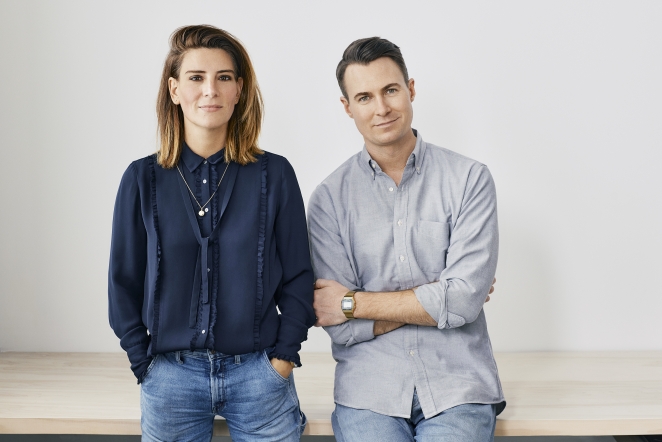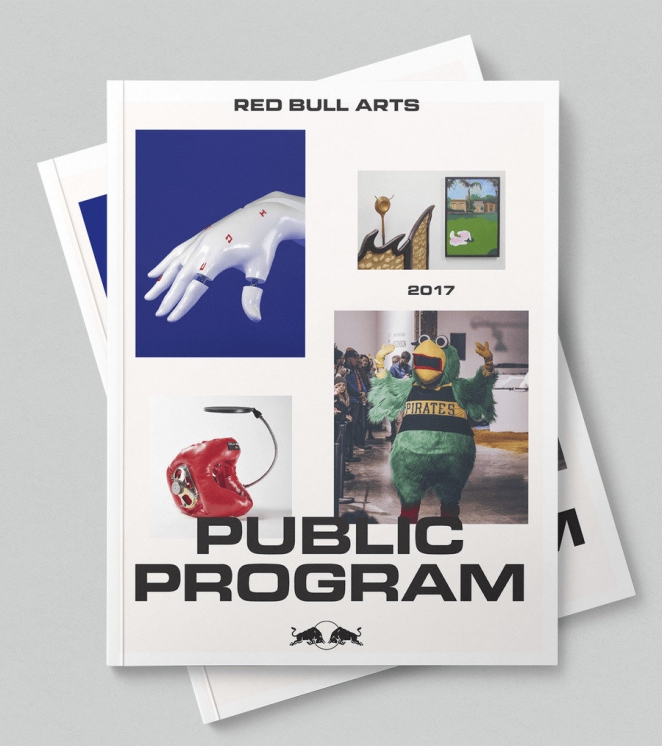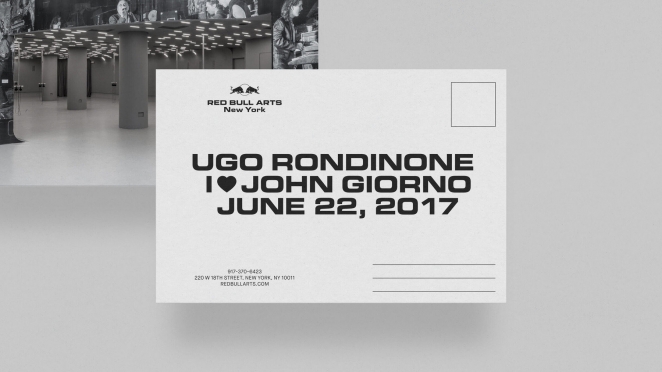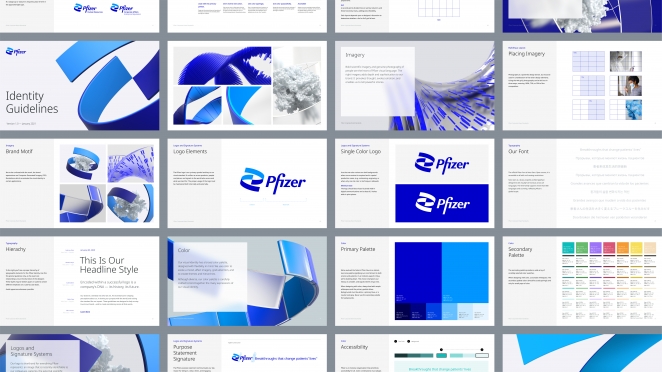We don't usually feature design studio heads in our Getting to Know series, but the Team bunch really caught our eye as a unique studio with some rather impressive names in their client list. They were responsible for the recent rebrand of Pfizer, to name one.
Team won the Pfizer account just at the right time to support the brand's skyrocketing popularity in the wake of the pandemic, and we have no doubt that these rising stars of design will work on more and more huge projects going forward. With a current team of 12 and the unique background of the two co-founders steering the ship, there is no place that the Team folks cannot reach.
Today we are Getting to Know Amy Globus and John Clark, Co-Founders of design studio Team. Here's how they managed to launch a successful design studio, nurturing some powerful organic growth over time.

Tell us a bit about your role! What is one typical day like?
John: We’re a strategic design studio based in New York—we transform and design brand identities for a variety of organizations, from cultural institutions, to start-ups, to multinational corporations. We’re a team of 12 and Amy and I are the co-founders and also the creative directors. We both work on the creative direction and the business development, as well as the day to day running of the studio.
Amy: Life at Team is fast-paced. Most of our time is spent taking clients calls, understanding many different challenges, and presenting design work. We have a flat hierarchy at our studio, so we spend lots of time chatting as a team, going through our designers’ work together, and making sure we’re all excited about where we’re heading with different projects through the lens of different perspectives.
What was the biggest challenge in getting to your current position?
John: When we were starting the business, we’d say yes to everything and would take on a whole range of projects, but it’s important to make sure you’re steering the ship as well. We want to make sure we’re growing, both in terms of the size of our studio and also the type of work we’re doing. Regardless of what type of project we're doing, and it will always be a range, it's important that the quality of our work is continually improving.
Amy: I find knowing when to scale to be the biggest challenge of running Team. We’re inundated with so many exciting work opportunities but from a business perspective, we want to make sure it’s sustainable for us. It’s all about scaling wisely as a studio and growing as creatives.

What is your personal background and what role did it play in your career?
John: I studied graphic design at the School of Visual Arts in New York City. I decided to study there because most of the professors were at the top of their field, had their own design studios, or were with great agencies. It gave me the opportunity to get a glimpse inside the process of running a design agency or working within one, while I was at school. Although I decided not to go and work for them, I was inspired to freelance and continue doing my own creative work after I graduated, which led me to starting my own studio.
Amy: As well as working at Team, I’m also a visual artist. Before we started the studio, I didn’t have a specific medium that I worked in, it was anything I could dream up – one year it might be crystals, the next it would be papier-mâché. It kept changing and I loved constantly experimenting and trying to figure out how to make sure the work turned out as good as it could be. And that’s what I do in my role now at Team, but for our clients. We figure out what the best path forward is for them and reimagine how we’ll approach it. How I worked as an artist has definitely influenced how I approach our projects now.
What is your biggest career-related win? What is your biggest loss?
John: Rebranding Pfizer was a huge project for us. While the branding effort was underway before the COVID-19 pandemic, we introduced the new identity as the company’s achievements in developing the breakthrough vaccine with BioNTech were being celebrated. It was an intense couple of months working remotely on the project, but the result was worth it. Collective awareness of Pfizer has skyrocketed in light of the pandemic and the company’s vaccine development, and it was crucial we created a new logo and identity that reflected both the company’s storied history and its bright future.
Amy: In terms of a career-related loss, on a personal level, leaving the gallery I was represented by before we started Team was difficult for me. To be represented by a gallery in New York, you have to be quite prolific as an artist and commit to producing multiple pieces of work. I felt like I didn’t fit in at the time, so I made the decision to leave. It was upsetting but it also pushed me into other avenues creatively. It wasn’t necessarily a loss as it helped me be creative in other ways that ultimately led me to where I am now.

What’s your secret to remain inspired and motivated?
John: We often think about other, much less desirable, things we could be doing professionally – this job can be stressful day to day but when you zoom out, we feel privileged to be doing something so creative, fun and fulfilling.
Which individuals and/or agencies do you gain inspiration from? Do you have any heroes in the industry?
John: When I was a student at SVA and a young designer, I looked up to a lot of the design ‘gods’ of the time, but as I’ve got older and as we’ve been running Team, I find that I gain more inspiration from our clients. Whether it’s a large corporation or a small start-up, the individuals, entrepreneurs, and business leaders we meet from so many different industries are super inspiring to us.
Also, when we speak to people who took risks to create businesses from scratch that they are passionate about, it’s really inspiring for our team. It’s fulfilling that we get to help them on their journeys and learn from them. As a studio, we don’t specialize in a certain industry because we learn so much from the different types of people and companies we work with every day.
Amy: We worked on the strategy and branding for Red Bull Arts, a non-commercial arts space dedicated to the cultivation and advancement of the arts, which was a really inspiring project to be involved in. Two young curators, Max Wolf and Candice Strongwater, saw the potential in the growth of corporate patronage, never sponsorship, for the arts and set up the organisation to support the production of new work by emerging and established artists and extend the boundaries of exhibition making. They were very passionate about giving back to the industry and the model they created was a generous one.

How has COVID-19 affected you?
Amy: It’s opened up opportunities to work with clients all over the world and businesses aren’t so sceptical about that. And cutting back on travel has given us and our team so much more time.
John: We did the Pfizer rebrand and several other projects remotely from all over the world, at all hours — we were doing the most important creative work of our careers, while trying to collaborate virtually for the first time. That experience really made us appreciate being in the studio together and reinforced those boundaries around protecting people’s time. The efficiency of being together again in the same time zone, in the same studio, means we can put our pencils down at the end of the day and pick it up tomorrow.
What is your biggest hope for 2021?
John: Each year we want to do better work than we did the year before and create projects that we’re proud of.
Amy: We’d like to grow the studio— maintaining momentum, achieving growth whilst sustaining the quality of our work is a big goal for us.

What is your one piece of advice to aspiring creative professionals?
Amy: Whatever you want to do in your career, you can make it happen. Don’t let people put caps on you and limit what you can achieve. Also, if you feel like you want to pivot away from a career you've invested time and energy into for a long time, it’s ok to walk away. Chances are you’ll apply your skills from that career moving forward, no matter what you end up doing. The human life span is long enough now to have multiple career trajectories.
John: We’re lucky to have a creative career and you can make what you want of it. Sometimes you’ll be rebranding the coolest start-up and other times you’ll be working on an internal presentation design for a huge corporation that on the surface might sound pretty dry, but you can challenge yourself to make it great. That challenge becomes more rewarding and so does the work. Regardless of what you’re working on, push to make it interesting and exciting for yourself.
Amy: Another piece of advice would be to rethink the norms of your industry. Everything is out-dating itself faster than you can imagine, so take a pause and think about how you’d approach something now versus what you’ve been taught or the traditional ‘right way’ to do it. What’s the best way for your clients to move forward or to approach a challenge, outside of the norm?

How do you recharge away from the office?
John: I love to travel whenever I can, near or far. Also, spending time with friends and family — and even if we end up talking about work outside the office, I think that’s fine, people in New York have the most fascinating careers that are often intertwined with their personal lives. As for recharging, I like to run, for exercise but also to clear my head.
Amy: I absolutely love to travel with friends and family. I am always up for a travel adventure, discovering new places, new foods, new friends — new everything. I also love to swim – I find lap swimming incredibly meditative and restorative.
If you weren’t in your current industry, what would you be doing?
Amy: I’d be a marine biologist and preservationist. I‘m fascinated by ocean life and sea creatures and have been underwater every chance I get to hang out with whale sharks, octopus and sea turtles. My family (husband Gareth and kids Hunter, 9, and Bowen, 7) have travelled around the world interacting (responsibly) with sea creatures of every kind.
John: That’s tough because I’m very happy with this career and didn’t find myself in it by asking “What industry would I like to work in?”. I have a lot of respect for editors and writers. Most of what I read is current events, essays, or nonfiction and that seems like a fulfilling thing to dedicate one’s professional life to (though I’m not sure I’d be any good at it). Maybe architecture.
Amy: John would be a fantastic architect.

What’s your one big dream for the future of the industry?
Amy: I would love to see less boundaries between mediums and practices, in industries like fashion, art, poetry, design, architecture, and even business. It would be so refreshing to have a universal acceptance, in organizations and practises, of a creative approach to all problem solving whilst relying less on the channel it’s delivered by.
John: I’d love to see a less insular future for the design industry. The most compelling aspect of the work we do is that it’s almost always in service of someone else's work. Sometimes as designers we can get caught up designing for other designers, critiquing and talking amongst ourselves, giving each other awards. At the end of the day we’re designing for others, not for ourselves.
Do you have any websites, books or resources you would recommend?
Amy: Some of my favourite books include Atomic Habits by James Clear, The Daily Stoic by Ryan Holiday, Homos Deus by Yuval Noah Harari and Think Again by Adam Grant.
John: Some of our clients' writing that I’ve been inspired by is The Business of Race by Gina Greenlee and Margaret H. Greenberg, and Who Can You Trust? by Rachel Botsman. I also recently read David Coggins’ The Optimist. It’s about fly fishing, among other things, and while it has nothing to do with design or business, it was refreshing.






